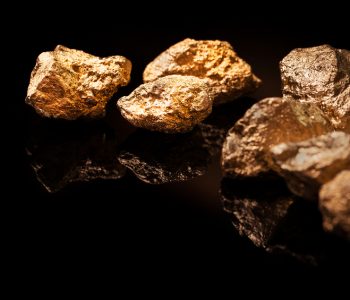10 Best Gold ETFs for 2017

Gold ETFs to Invest in 2017
Since 2011, the price of gold has been trading on a downtrend, and in 2016, seemed to be forming a base and had a positive return after many years of negative returns. The question now is if this the time to consider having exposure to the gold sector.
Having exposure to the gold sector has one unique characteristic that many other investments do no offer: protection from inflation. This is because gold is known as an investment that is inflation-protected.
I mention inflation because since 2015, there has been two interest rate hikes by the U.S. Federal Reserve. One of the key metrics that they weigh heavily before considering making a change to the benchmark interest rate is how inflation is impacting the economy. When there is currently inflation, or at least the potential for it, the Fed tends to increase the benchmark rate.
Said rate has been on a trend of an upward slope, which could continue this trend since interest rate are still at record low levels.
One method to consider to protect yourself from inflation is owning the best gold exchange-traded funds (ETFs). I mention ETFs because an investment will be made into a portfolio of mining companies, rather than owning one single business. A few ETFs are special because they have exposure to gold, which is not easy to access as a retail investor.
I have provided a list of the best gold ETFs to invest into in 2017, which includes dividend-paying gold ETFs that hold companies with operations in mining for gold and other precious metals. One of the best gold ETFs to consider is also the largest and owns physical gold bars and tracks the price of the precious yellow metal.
Below is the top 10 gold ETFs list that should be considered for ownership.
| ETF Name | Symbol |
| Sprott Gold Miners ETF | SGDM |
| Market Vectors Junior Gold Miners ETF | GDJX |
| Powershares Global Gold and Precious Metals Portfolio | PSAU |
| iShares MSCI Global Gold Miners ETF | RING |
| VanEck Vectors Gold Miners ETF | GDX |
| Global X Gold Explorers ETF | GOEX |
| ALPS Sprott Junior Gold Miners ETF | SGDJ |
| AdvisorShares Gartman Gold/Euro ETF | GEUR |
| SPDR Gold Trust (ETF) | GLD |
| Credit Suisse X-Links Gold Shares Covered Call ETN | GLDI |
1. Sprott Gold Miners ETF
Sprott Gold Miners ETF (NYSEARCA:SGDM) seeks to track the performance of the Sprott Zacks Gold Miners Index. The focus is holding mid- and large-cap companies that are listed on major U.S. trading exchanges; this would include both common shares of both gold and silver companies and American depositary receipts (ADRs). The holdings within the ETF are reviewed on a quarterly basis to ensure the company still has expected future growth when investments were made.
More than 90% of the assets are invested in gold companies and some of the largest holding includes: Agnico Eagle Mines Ltd (NYSE:AEM), Barrick Gold Corp (NYSE:ABX), and Randgold Resources Ltd. (NASDAQ:GOLD).
2. Market Vectors Junior Gold Miners ETF
Market Vectors Junior Gold Miners ETF (NYSEMKT:GDJX) tracks the Global Junior Gold Miners Index. Half the assets are typically invested in gold and silver mining companies that generate their revenue from a royalty stream or mining projects, while the other half are companies that are currently in the development stage before mining begins.
Top holdings within GDJX include B2Gold Corp (NYSEMKT:BTG), Alamos Gold Inc. (NYSE:AGI), and IAMGOLD Corp (USA) (NYSE:IAG).
Even though the investments are made in smaller-market-cap mining companies, the day-to-day volatility is actually less than the overall market. This is according to the GDXJ ETF’s beta,of 0.80, which is compared to 1.0 for the overall market.
If you are considering a ownership stake in GDXJ, it is a great way to get exposure to smaller-market-cap gold and silver mining stocks. One reason is because GDXJ is very liquid, plus smaller mining stocks is at times difficult to purchase due to liquidity issues. Another advantage is that is there many small-cap companies within the fund, which adds to the diversification and removes the risk of owning just one small-cap gold mining stock.
3. Powershares Global Gold and Precious Metals Portfolio
Powershares Global Gold and Precious Metals Portfolio (NASDAQ:PSAU) seeks to replicate the NASDAQ OMX Global Gold and Precious Metals Index. Fund investments include owning common shares, ADRs, and global depositary receipts (GDRs), which is very important to know before considering an investment in PSAU.
The fund owns companies that are listed on different trading exchanges around the world, which adds a little extra risk based on the direction of the U.S. dollar. If the greenback gains against the currencies on which an investment is made, it will impact the ETF negatively. In addition, the reverse will occur if the U.S. dollar falls against the basket of currencies, resulting in an addition gain for the overall fund.
Some of the top holdings within the fund include Franco Nevada Corp (TSE:FNV), Kinross Gold Corporation (TSE:K), and Silver Wheaton Corp (USA) (TSE:SLW).
4. iShares MSCI Global Gold Miners ETF
iShares MSCI Global Gold Miners ETF (NYSEARCA:RING) tracks the results of the MSCI ACWI Select Gold Miners Investable Market Index. Approximately 90% of the fund’s assets are invested in companies that are part of the index or companies that have similar characteristics to the companies within the index. The focus for the fund is owning companies in both developed and emerging markets.
The top three holdings—Barrick Gold Corp (TSE:ABX), Newmont Mining Corp (NYSE:NEM), and Goldcorp Inc. (TSE:G)—account for approximately a third of the investable assets within the fund. These companies are considered as the heavyweights in the gold sector, with a long history of operations. The rest of the fund is invested in both large- and small-cap companies.
The dividend is paid on a semi-annual basis and has been growing over time. The dividend is not a steady payment, but rather dependent on a few factors, such as how the fund has performed and the dividend that has been received within the fund.
5. VanEck Vectors Gold Miners ETF
VanEck Vectors Gold Miners ETF (NYSEARCA:GDX) seeks to replicate the price and yield on the performance of the NYSE Arca Gold Miners Index. At least 80% of the fund’s assets are invested in gold mining companies. This is not a pure play on gold miners; there is also exposure to companies that mine for other precious metals, such as silver and platinum. These other metals do not account for more than 20% of the fund’s investments.
The holdings are mid-cap growth companies and more than half of the assets within the fund are invested in companies based in Canada; the rest are in the U.S., Asia, and Africa. These have a presence around the world, which adds to the diversification of GDX.
The dividend is paid on an annual basis in December. However, the payment has not been steady. The management team of the ETF determines how much to pay out to unitholders before the payment is made based on dividend returns and capital gains within the fund.
6. Global X Gold Explorers ETF
Global X Gold Explorers ETF (NYSEARCA:GOEX) tracks the performance of the Solactive Global Gold Explorers Total Return Index. The fund tends to invest at least 80% of its assets in gold exploration companies listed on the U.S. and global trading exchanges.
The focus for the GOEX ETF is investing into small-cap growth stocks. This may sound like companies with a lot of risk, but this is not the case. In fact, GOEX has a third less volatility than the overall market index, based on a comparison of the beta.
When it comes to the dividend, it is paid out once a year every December and done on a case-by-case basis. In 2016, the dividend amounted to a yield of 34%. This large amount was because the fund contained a large amount of capital gains.
When the dividend is paid next year, the range of the yield will depend on the performance of the companies within the fund.
7. ALPS Sprott Junior Gold Miners ETF
ALPS Sprott Junior Gold Miners ETF (NYSEARCA:SGDJ) seeks to replicate the Sprott Zacks Junior Gold Miners Index. The index is rebalanced semi-annually to ensure that the latest company results are reflected in the index, therefore changing the fund as well. There are two factors that influence the index: relative revenue growth and the price momentum of the company.
The holdings within the fund are made in junior gold and silver companies that are listed on major U.S. and/or Canadian exchanges. Investments are made into companies that are in early stages of the exploration phase and are close to producing gold or silver.
The dividend is paid on an annual basis in December of each year.
8. AdvisorShares Gartman Gold/Euro ETF
AdvisorShares Gartman Gold/Euro ETF (NYSEARCA:GEUR) seeks to provide returns by using the euro to invest into the gold market. This gives investors an opportunity for exposure to a gold investment using a currency besides the U.S. dollar.
The portfolio managers of the fund use future contracts to remove the risk of the currency on a cost-efficient basis. This adds to an investor’s diversification of owning a gold product and one in a currency other than the greenback. Constructing this type of product as a retail investor is quite difficult and expensive to do, but owning GEUR takes all that concern away.
9. SPDR Gold Trust (ETF)
SPDR Gold Trust (ETF) (NYSEARCA:GLD) represents the performance of the actual commodity of gold. The gold within the fund is held within a trust as gold bars. The only time that gold bars will be sold is if there is heavy redemption and a need to balance the portfolio.
GLD does not pay a dividend to its unitholders, but remains, in my opinion, one of the best gold ETFs to buy since it is the biggest gold ETF on the market.
This is an alternative means of accessing the gold market without owning an ETF that invests in mining companies. Also, the GLD ETF is simple to understand, since there are only gold bars being held within the fund.
Another reason to keep GLD in mind is because retail investors often find it difficult to find a investment that tracks the price of gold, as this one does. Typically, in order to gain exposure to this asset class, you need to purcahse either derivatives or future contracts.
10. Credit Suisse X-Links Gold Shares Covered Call ETN
Credit Suisse X-Links Gold Shares Covered Call ETN (NASDAQ:GLDI) is a senior unsecured debt security that is issued by Credit Suisse Group AG (NYSE:CS). With GLDI being a debt product, it is known as an exchange-traded note (ETN), but trades just like an ETF. ETNs are an alternative method to getting exposure to the gold sector and receiving an income.
GLDI holds a long position in the shares of this list’s ninth entry, SPDR Gold Trust ETF. Income is generated thanks to the use of a “covered call” strategy, which is used to generate income against the existing GLD position. This strategy continues to be used on a monthly basis and, as a result, pays a monthly dividend to unitholders.











